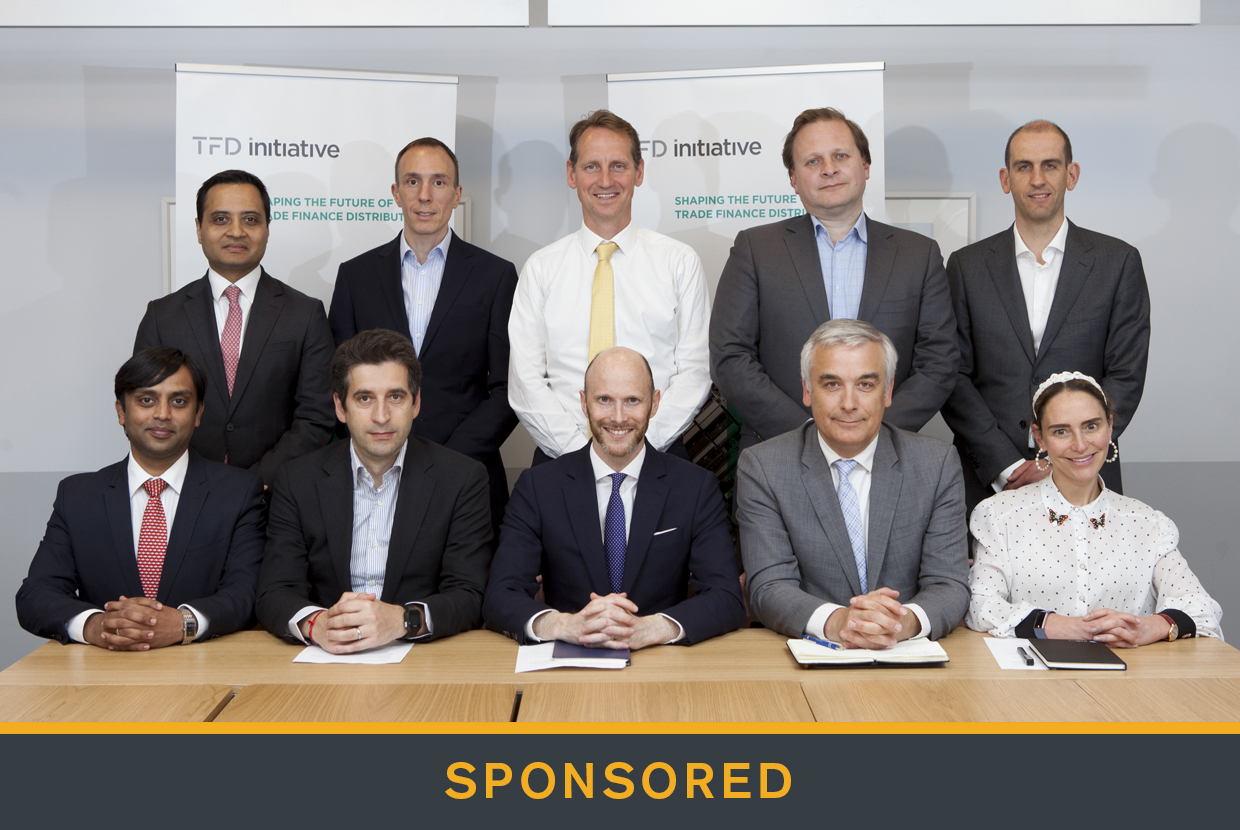The Trade Finance Distribution (TFD) Initiative has been created to drive standardisation for the distribution of trade finance assets on a new fintech platform. This roundtable discussion brought together some of the banks involved in the initiative, plus Tradeteq, its technology provider, to debate the need to expand the distribution of trade assets and the network of trade finance investors.
Roundtable participants:
Nils Behling, co-founder and CFO, Tradeteq
Michael Boguslavsky, head of AI, Tradeteq
André Casterman, CMO, INTIX; chair, ITFA’s fintech committee (chair)
Richard Evans, managing director, global head of trade asset distribution, Citi
Francesco Filia, CEO and CIO, Fasanara Capital
Christoph Gugelmann, co-founder and CEO, Tradeteq
Dalia Kay, vice-president, senior portfolio manager, senior investment analyst, Federated Investors
Surath Sengupta, managing director and global head of trade distribution and portfolio management, HSBC
NLN Swaroop, senior vice-president, portfolio management and distribution, GTRF, HSBC
Anthony Van Vliet, global head of trade and commodity finance, ING
Casterman: Over the past 10 years, banks have come under pressure from regulators to reduce the amount of risk held on their balance sheets. How is this influencing your trade finance operations?
Van Vliet: There is a negative trend on the cost of operating a bank in trade finance. Not only is cost of capital going up, but so are compliance-related risks, and clearly this has a big impact.
What I find interesting is that the leading banks in the commodity and trade finance industry are Dutch and French banks primarily based in the eurozone, whilst this industry is fully dependent on US dollars. European banks are not necessarily the natural hub for competitive access to dollars, whilst these banks are the main originators and funders of US dollar-denominated trade finance transactions.
Historically, distribution is not something we have focused extensively on, but in the last year or two it has become a much more strategic focus for the bank. So, will we massively sell assets in our portfolio? No. But will it become and has it become a key priority? Yes.
Evans: Citi is in a slightly different position as a US dollar bank. It’s no secret Citi has operated under an originate-to-distribute model – and not just in the trade business. I don’t mean that we originate business which we are not happy to keep on the balance sheet and just want to distribute. We originate primarily with one driver, and that is because our ability to originate business simply outstrips our credit capacity to build that business. 99.9% of the time we will keep a portion of the individual transaction that we’re originating, so we almost never sell out of a transaction completely, we’ll always keep a portion of the risk on Citi’s balance sheet. We’ve been operating on that model for quite some time. We are extremely focused on developing that further and in particular on developing a broader, deeper and more differentiated investor base as we start to look at the volumes which will need to be distributed this year and over the next few years.
Sengupta: There is clearly an increased recognition of getting the appropriate level of returns on the capital that we invest in any business, and that includes trade as well. This means that we need to be more intelligent on how we are going to use the capital, and one of the levers is, of course, using the secondary market, or the liquidity that is available in the secondary market, from both other banks and non-bank investors as far as possible.
Kay: Banks are now able and willing to share some of their assets. Previously, they were just holding on to assets until maturity as investors. For funds like ours, this is an advantage – we get access to transactions that we didn’t have access to before, so it’s a plus.
Casterman: What is the view from the fintechs on this point?
Behling: For us it is important that we work with the banks in their distribution efforts, and we certainly see that banks are very interested. There are of course established channels where banks distribute to other banks, and it is financial institution (FI) risk mostly that gets sold down: letters of credit, guarantees-type business. Where there is a shift and where we want to come in is the access to non-bank investors. The demands of these investors are different from those of the banks, not only in terms of the product but also in terms of the access. How do I invest? How do I take delivery of the underlying assets? How much time and effort can I spend on individual receivables? What’s my capability of analysing them? All these are topics that we as a fintech company are very interested in, because we strongly believe that these issues can be solved with technology.
Filia: A perspective on the buy-side: when we started our activities in this space, we focused purely on fintech-originated trade receivables. We perceived ourselves as a challenger-like entity to the traditional banking channel. But then, over the years, we realised that the banks were actually not so much a competitor but rather a player and a partner on the origination side. And in the last few years in particular, we have increasingly started to integrate the originations from the banking side within our fintech. We realised that quality origination can only come from banks. They have had boots on the ground for several centuries in their respective jurisdictions, and they can help greatly in boosting volumes in a sustainable manner. Now that the technology is available, especially through the Tradeteq platform, through the proper type of analytics, it is possible to combine good origination from traditional banks, together with new technologies to make it sizeable.
Casterman: So the banks are making the market, and the buy side players are keen to see this market growing and to help the banks?
Gugelmann: Post the credit crisis banks have been very good at highlighting the unintended consequences of tighter regulatory rules on trade finance and the real economy. Following the early successes of the ICC trade register, there is not much more you can get in terms of further capital relief and leverage relief on trade finance at this point. The time is right for an originate-and-distribute model. The market now needs to expand the bank-to-bank syndication structures and include non-bank financial institutions.
Sengupta: Trade finance origination has been led by banks and I don’t see that changing fundamentally but the market participation is likely to become wider with greater interest amongst non-bank investors to participate in this low-risk real economy asset class. Going forward, I see bank and non-bank players working more closely to increase availability of trade finance by making this asset class more investible.
Casterman: Although there is growing appetite amongst institutional investors to buy trade finance assets, they account for a relatively small slice of the market. What are the barriers holding back greater levels of participation?
Kay: For institutional investors, one of the key things is that there is no index for trade finance.
The other point is that institutional investors do not understand the market like bankers do. There is a stage where they need an investment advisor who can explain to them the process and how they can invest. As an investment manager, I also need details and granularity to fully assess where the money is invested into.
Gugelmann: There is a role for a fiduciary asset manager, which many funders require, but the process needs to be more efficient in order to solve the pain points relating to credit analytics and investment automation.
Filia: On the buy-side, we see a lot of appetite from institutional investors. Currently 90% of our investors are institutional investors, insurance companies, pension funds, and part of the appetite is that they look for yield at a time where we have a zero-interest rate environment. They need to look out for alternatives and be a little bit more open-minded than they were in the past.
In the past, they were completely satisfied by the availability of the corporate bonds, government bonds, high yield bonds. Today, they tend to look for something more. That leads them to different things that they were not exposed to in the past, like financing receivables. Today, analytics and new technologies are helping them have better transparency and better access to sources of capital.
The regulation is pushing the sell-side into the same camp, so they meet halfway and there are incentives on both sides. It’s quite remarkable that we were able to lure institutional investors into this space because it’s quite new. It speaks to the potential and the trend.
Van Vliet: This is a relatively new asset class for investors. We have seen various funds and new initiatives come up, but really only in the last few years. Some of the traders have set up their own funds. Education of other non-bank investors in the commodity and trade finance world is key. It is an asset class that is not easily understood: on the one hand people see a combination of emerging markets and fairly low returns, and in the mindset of an asset manager, why would you do a sub-2% return in a country that is an emerging market? But the reality is that commodities are strategic products which are not consumed locally so there is a push out factor, the goods will hit the world markets at the world market prices and it’s very short-term. Plus, banks monitor their collateral – the goods – on a daily basis.
In my experience, trade finance distribution will start smaller, but it will grow in scale. So, for example, if I look at where we have opened up the trade finance market in Asia, the size of some of the first deals we did 10 or 12 years ago were single-digit millions. But now it is hundreds of millions: the same thing will happen here.
We also have to be clear that you have to pitch your product right. With some investors we have found that if we can pitch trade finance as an alternative to cash, which would attract negative yields, and of low risk, then suddenly it makes it a very attractive proposition for them. You need to learn to bridge cultures and speak each other’s language, and we have probably not always been good at that.
Finally, it has to be clear that there is de facto an arbitrage game, because us banks are generating assets for which we are required to put a certain amount of capital aside. Asset managers, pension funds, insurance companies and other non-bank investors have different rules or are sometimes not regulated.
Sengupta: Just to add to what you are saying, as of today there are primarily two ways that institutional investors invest in billions in trade finance secondary market. One is by securitisation of assets using traditional tranches and the other is purchase of supply chain finance or payables. The reason is very simple, because with these you can pinpoint what exactly the institutional investors are buying, and they understand these structures and as a result there is ample liquidity from the investors.
Other than these two, we have not yet seen much growth in unsecuritised receivables finance or trade loans, and then you have the whole host of unfunded products, which is a different ball game altogether. The reason is that these products have a completely different set of risks, which is very difficult for alternate investors to understand. Over a period of time, banks have developed infrastructure to manage the risk and service these products. I don’t see investors creating and replicating that infrastructure.
So we have to build a bridge for alternate investors in such a way that they are able to invest in these risks, but where they can see the exact risk. Whose risk is it? How much is it? And what tenor is it? The moment we create this bridge, automatically the whole appetite would open up. That is the challenge that all of us collectively need to solve.
Evans: It’s absolutely essential to the trade business that we bring institutional investors in.
In 2019, Citi will likely distribute in excess of US$100bn of trade assets into the market. That will go almost entirely to banks. It is all on a funded basis and is primarily from our supply chain finance business and our trade receivables business. Our distribution model, much like our corporate supply chain models, is a just-in-time model with almost absolute flexibility. This means that our programmes have a list of investors who approve that programme, and we will sell to them when we need to, which is on a daily basis, but it is almost just in time, and that provides many benefits. I would estimate that the number would grow at least 10% year-on-year, just from the growth in Citi’s trade business as we continue to improve technology, for example in our supply chain finance business, as well as improve supplier onboarding, etc. It is vital that we look at tapping the institutional investor space.
There are certain hurdles in the way of doing this in a scalable manner, and the first one is that we will likely need to stop talking about ‘trade assets’, because trade assets bring with them a whole world of very different risks. Take our supply chain finance business for example. This business accepts invoices and is basically commercial paper from an institutional investor perspective. And they understand that very easily.
If I look at all our supply chain finance programmes, and compare them to, for example, trade receivables securitisation deals, then this is a much more complex asset structure, and we are going to have a very different investor base for such securitisations. Pricing is different and we are taking different risks. But to explain those two transactions to an investor, there is no point calling them both trade finance transactions because they are worlds apart. And that is before we even get onto funded LCs, etc.
There is a very basic education step that we need to do in terms of which investor base is interested in which of the trade finance products that we offer.
The other point to raise is about mechanics and the bridge that we have to build here. At the moment banks have been fairly spoilt. There isn’t really a bridge at all. We sell generally via standard risk participations, English law or New York law, and we don’t do anything to the assets. We try to group them in a way that makes sense for people to be able to fund. But we’re not really required to do anything in terms of repackaging those assets. They are sold line by line, programme by programme, because up until now the appetite has been there in the bank world.
As we look at the mechanics of delivery, from a bank perspective, we are generally asking two things. Firstly, we have got to see a path to scale in anything we build, because a bespoke solution, deal by deal, just doesn’t cut it when we are talking about distributing hundreds of billions. The second point is, what is the cost of building a different delivery mechanism for institutional investors? We all share the view that maybe the institutional investor space is at a better price point, but what is the cost of the delivery mechanism we need to build going to add to the pricing at which we distribute?
Casterman: We have talked about the appetite on the origination side and on the investor side: how can technology help in the middle?
Gugelmann: Trade finance is not a trivial asset class whatsoever. It comes in many forms and shapes. Risks and yields in trade finance are generally lower than in other instruments. The portfolios can be highly granular, and the instruments are mostly short-term. Tranching is harder to achieve and only a very few and rated bank balance sheet securitisations have been successfully implemented.
Technology can create full investment automation and help with risk transparency, particularly where there is mostly no risk tranching involved.
With regards to investment automation, very few funds have built bank-like trade finance infrastructures. Many investors require readily available capital market products, and trade finance asset managers want to scale efficiently. This requires standardisation around reporting, reconciliation and automated workflow management for a very large number of short-term instruments.
Risk transparency can be achieved by making predictions on the basis of operational and behavioural aspects. The behavioural aspects of trade finance are fundamental, but credit rating agencies are not covering this adequately at the moment.
Behling: The access to, and the delivery of, information is important for an investor. Sending a pension fund 1,000 line-items of receivables over a spreadsheet and saying: ‘This is the portfolio, let me know later today whether you like it or not,’ is just not efficient. So, you have to deliver not only the product, but also the information in a way that is intuitive, easily consumable, and almost humanised in the way it is presented. Technology can cut through the fog of complexity and inefficiency and deliver targeted reporting, detailed analytics, and provide the information that an investor needs in order to feel comfortable with this type of investment.
Boguslavsky: Talking about transparency and indices, if we look at the markets where indices are widespread, first you need differentiation in the products that are available. For example, in fixed income, you had the universe of rated bonds first; after that, the market created bond indices determined by different parameters. In equities, market capitalisation of a company and liquidity of shares remain the key measures of quality. These types of equity assets had to become prevalent before the main indices came into existence. So, before you can have a meaningful index in the trade finance market, there needs to be much better transparency. Transparency on the yield is relatively simple – if you have a paper, it usually informs the kind of yield you can expect as an investor. Transparency on the risk, however, is much harder to achieve, and to become more transparent this needs to be established before an index.
Sengupta: Currently we have a very inefficient and costly way of distributing assets: through manual bilateral phone calls to each other. Technology has a massive role to play in changing this radically.
What are we trying to achieve? We are trying to achieve standardisation. How can we standardise this as much as possible so that everybody understands this? This needs to start from origination stage itself and distribution should be a mirror of origination. All the technology work that is happening, including blockchain and others on the origination side, will have a knock-on impact on distribution, and we need to open our minds to thinking how we can start leveraging those in the secondary market as well. If you really start thinking about the elements of distributed ledger technology, they can actually drive standardisation and transparency in the risk very fast.
Van Vliet: I think this will really make us smile five or 10 years down the road – the way assets are distributed now compared to how it will hopefully be done in the future.
Right now, the key step we have to take is to connect the originators to the investors, because that is still a minimal part of the transactions that the industry collectively generates.
Casterman: We agree that technology is key to building this bridge to the new types of investors. How can we achieve scalability? How is the TFD Initiative helping the market to achieve this scalability?
Gugelmann: There are three components. One is to be able to connect sellers and funders. Then there is the collaboration between institutions to efficiently negotiate transactions and understand each other’s parameters. And finally, there is the transaction component, where parties require an end-to-end infrastructure, such that they can automate certain processes which are currently often done on a spreadsheet basis. That includes reporting but also credit analytics, which all thrives off the same data sets.
Other recent technological developments on the origination side, such as DLT, are important, since they are all driving digitalisation, which again makes trade finance distribution possible.
Van Vliet: The key word for me is co-creation. The TFD Initiative is one example. Historically, everyone has tried to do things on their own and then come up with their own perfect magic solution. Now, the name of the game is to work together as an industry, to share cost and to ensure you achieve market adoption and set new standards.
It is not a level playing field, because the expertise of a bank as an originator does make a difference. Also, in a digital world full of blockchains, relationships do matter. It is not going to be robotised; it is still going to be, for example, your institution and my institution working together because we trust each other and value our respective expertise and capabilities.
Sengupta: What I’m expecting from this initiative is that we all work together to build this bridge, which we have talked about. This bridge will be facilitated by technology, but there has to be a meeting of minds in terms of actually wanting to do this. So, firstly, are banks prepared to really invest in this? And I don’t mean invest with money, but actually invest the whole intent? Are we willing to open up this market for investors to come in? And how we going to allow that? Trade finance is originated by banks: it has been a bank asset class for hundreds of years, so what is the role that we see for investors and how much do we see them playing this role? We need to be very clear about that.
I personally think that there is a role that investors have in this, which is to support with additional liquidity the relationships that the banks have.
Casterman: Let’s hear from the buy side what they expect from the TFD Initiative in terms of technology and scale.
Kay: There is a level of transparency that has got to be given, because often what the seller wants to show the buyer, and what the buyer wants from the seller, can differ. And it is important that both sides are able to see exactly what they expect to see in order to be able to make an investment decision that is reasonable within the parameters that they have been given. For example, if you are shown a receivable, you will see the name, maybe a credit rating, but perhaps not all the information needed to make an informed investment decision. If you can add accessibility to transactions that correspond to your eligible criteria of investment, then you get an ability to review the credits you want to eventually buy. When looking at receivables I would expect to see the borrower’s name, and its parent, the amount offered, the currency, the goods and their status, the maturity date and, of course, the pricing.
Filia: Because we built our experience over on the fintech side of things, through technology, we have been able to standardise this in the eyes of institutional investors. We try to help with originating the first few transactions because, from our perspective, there will not be just one single model, but rather a few different models which will create the market. We just try to help with the first use cases, the first active and practical transactions for institutions. I will also just reiterate the point that there is a huge appetite. Institutional investors are desperate for it these days. It hits their sweet spot. Already at 200 bps we find investors lined up.
Casterman: We have identified that there is a need for a new bridge between originators and institutional investors. Technology will make it happen. The TFD Initiative is there to add standardisation and drive automation to get to a scalable model. Can you tell us more about the next steps of the initiative and how this co-operation will take place?
Behling: The TFD Initiative was started by a few banks and non-bank investors together with Tradeteq and it is growing significantly. There are now more than 19 members in the initiative, among them the world’s major trade finance banks. There is huge interest in this space and around how to grow it and that is key to the success of the TFD Initiative as an industry-led drive. We are also talking to one of the leading worldwide trade associations to take a bigger role in the TFD Initiative because we want to build common standards for trade finance distribution and get the widest possible buy-in from the banking and investor communities.

















